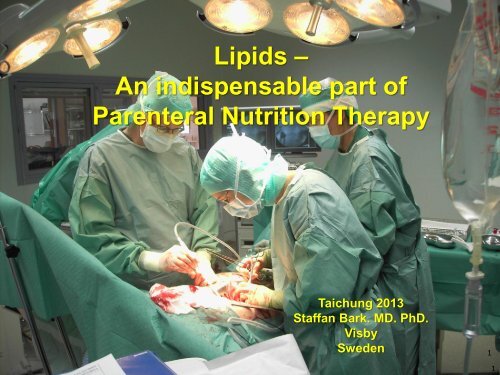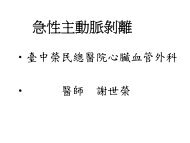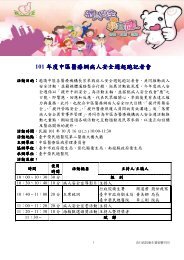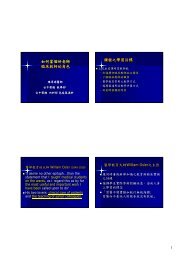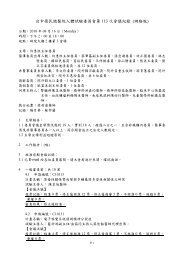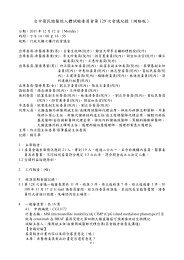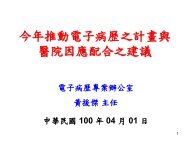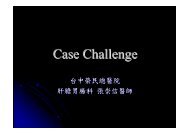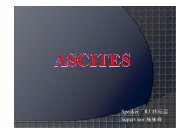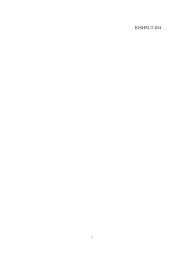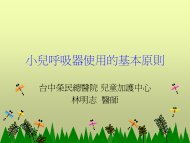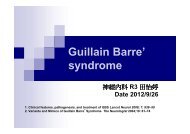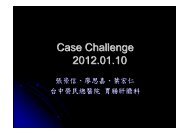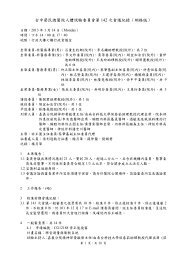Lipids â An indispensable part of Parenteral Nutrition Therapy
Lipids â An indispensable part of Parenteral Nutrition Therapy
Lipids â An indispensable part of Parenteral Nutrition Therapy
You also want an ePaper? Increase the reach of your titles
YUMPU automatically turns print PDFs into web optimized ePapers that Google loves.
<strong>Lipids</strong> –<br />
<strong>An</strong> <strong>indispensable</strong> <strong>part</strong> <strong>of</strong><br />
<strong>Parenteral</strong> <strong>Nutrition</strong> <strong>Therapy</strong><br />
Taichung 2013<br />
Staffan Bark. MD. PhD.<br />
Visby<br />
Sweden<br />
1<br />
1
Our most common worries<br />
• Mortality, <strong>of</strong> course<br />
• INFECTIONS<br />
• Multiple Organ Failure<br />
• Leaks (post-op)<br />
2
Which tools do we have<br />
• Good clinical practice<br />
Surgical technique, understanding the problems,<br />
clean/sterile care, etc<br />
• <strong>An</strong>tibiotics and other drugs<br />
What about MRSA<br />
• <strong>An</strong>y other tools<br />
3
Complications in surgery<br />
% weight<br />
loss<br />
30<br />
28 cases 20%<br />
6 deaths = 33.3%<br />
20<br />
10<br />
Mechanical ileus<br />
Wound ruptures<br />
Pneumonias<br />
Sepsis<br />
0<br />
Studley, 1936<br />
4
Assessment <strong>of</strong> a novel screening score for nutritional risk<br />
in predicting complications in gastro-intestinal surgery<br />
Schiesser M et al. Clin Nutr 2008, 27(4):565-70<br />
608 elektive surgical patients (Zürich, Switzerland)<br />
Prospectively evaluated with ”<strong>Nutrition</strong> Risk Screening 2002”<br />
”Overall <strong>Nutrition</strong> Risk incidence” was 14%<br />
Serious complications in patients with increased risk:<br />
54% vs. 15% p
Fatty acid-structure<br />
Essential fatty<br />
acids<br />
6
The lipids are the same today as on<br />
the time <strong>of</strong> Hippocrates and before<br />
We have been adapted to lipids<br />
during the evolution<br />
(as for everything else except poison)<br />
7
Intralipid<br />
registered 1962<br />
Vitrum<br />
8
Effects:<br />
Essential fatty acids<br />
Energy<br />
11
Long chain Soybean<br />
Myristic C14 0.1<br />
Palmitic C16 11.0<br />
Stearic C18 4.0<br />
Oleic C18 23.4<br />
Linoleic C18 53.2<br />
Linolenic C18 7.8<br />
Arachidic C20 0.3<br />
linoleic acid<br />
alpha-linolenic<br />
acid<br />
palmitic acid<br />
stearic acid<br />
oleic acid<br />
12
PUFA and<br />
- risk for oxidative stress <br />
Difficult to evaluate clinically<br />
- many parameters have been used<br />
and many contradictive results<br />
Isoprostanes, MDA, TBARS, TRAP,<br />
pentane etc<br />
13
Oxidative stress – not a simple event<br />
14
PUFA and<br />
- risk for oxidative stress <br />
No difference in MDA between<br />
Intralipid, Olive oil-emulsion or mothers<br />
milk<br />
Cipierre et al, Acta Paediatr 2009<br />
No difference in F2-isoprostanes and TRAP<br />
between Intralipid, MCT/LCT or Olive oilemulsion<br />
Roggero et al, <strong>Nutrition</strong> 2009<br />
15
The effect <strong>of</strong> sepsis on the<br />
oxidation <strong>of</strong> carbohydrate and fat<br />
Stoner et al. Br J Surg 70:32-5, 1983<br />
8<br />
Glucose<br />
oxidation<br />
g/m 2 /h<br />
Sepsis score 0 10 20 30<br />
Fat<br />
oxidation<br />
g/m 2 /h<br />
3<br />
0<br />
Sepsis score 0 10 20 30<br />
16
Increased lipid fuel dependence in the critically ill septic patients<br />
Nanni et al, J Trauma 24(1):14-30, 1984<br />
17
Phosphate & Fatty acids<br />
18
Hospital<br />
stay<br />
Health<br />
0 12 14 26 38<br />
Time (weeks)<br />
19
July-August<br />
Complaining about gases<br />
and abdominal distention<br />
Female 88 years<br />
Could be your grandma<br />
Weekend Aug 26-27,<br />
anorexia, doesn’t eat much,<br />
drinks a little fluids, loose<br />
stools,<br />
upper abdominal pains<br />
Gets worse during the week<br />
and her daughter takes<br />
her to ER on Saturday<br />
Sept 2nd<br />
Cannot eat<br />
20
At admission late afternoon<br />
complaining about pain<br />
mainly in the upper <strong>part</strong> <strong>of</strong><br />
abdomen<br />
A little underhydrated,<br />
slightly anemic, nothing<br />
special on physical exam,<br />
has had a couple <strong>of</strong> loose<br />
stools during the day<br />
borderline albumin<br />
To the ward for<br />
observationtion (Saturday<br />
evening). Prescribed 5%<br />
glucose<br />
Female 88 years<br />
21
Sunday Sept 3 rd<br />
Same problems. Diarrhea<br />
Refuses to eat or drink.<br />
Sent for X-ray – overview <strong>of</strong><br />
the abdomen shows signs<br />
<strong>of</strong> an ileus with an empty<br />
left colon<br />
Suspicion <strong>of</strong> an obstruction<br />
in the left colon<br />
Discussion with radiologist<br />
on call to get a CT – denied<br />
due to overload <strong>of</strong> work<br />
Prescribed 5% glucose<br />
Female 88 years<br />
22
Indirect calorimetry<br />
24
REE for women<br />
655.0955 + (9.6534 x weight) + (1.8496 x height) -<br />
- (4.6756 x age)<br />
REE for men<br />
66.4730 + (13.7516 x weight) + (5.0033 x height) -<br />
- (6.7550 x age)<br />
25
The eyeball method<br />
26
Plus+<br />
MINUS<br />
AND RARELY MORE<br />
THAN<br />
2000 kcal<br />
27
Different combinations <strong>of</strong> glucose and fat…<br />
Suitable for peripheral infusion<br />
Lipid Lipid Lipid<br />
X<br />
Glucose Glucose<br />
Lipid<br />
Glucose<br />
Compounding<br />
Glucose<br />
In principle and<br />
following physiology…<br />
… only indicated when<br />
lipids are intolerated<br />
Glucose<br />
…all works as long as no overfeeding with any component<br />
Remember: Too much glucose is harmful and tumor cells<br />
prefer glucose as substrate<br />
28
Increasing glucose intake during total parenteral nutrition increases<br />
norepinephrine excretion in trauma and sepsis<br />
Nordenström et al. Clin Physiol 1981,1:525<br />
7<br />
6<br />
5 n.s.<br />
4<br />
3<br />
2<br />
1<br />
0<br />
Lipid 50:50<br />
Lipid:glucose<br />
p
Hyperglycemia is a major threat against a good outcome<br />
How to control it<br />
• Avoid too much glucose<br />
• Use insulin<br />
• Dual, physiological energy (glucose + lipids)<br />
• Control stress = control glucose intolerance<br />
30
Monday Sept 4 th<br />
Ordinary staff on duty<br />
<strong>Nutrition</strong><br />
Yes, she receives a bag<br />
with Kabiven 1000 kcal<br />
(bw 49 kg – has lost approx.<br />
3 kg the last 2-3 weeks)<br />
i.e. approx 20 kcal/kg<br />
Peripheral vein<br />
31
Malnutrition Increases Postoperative Complications<br />
Subjective Global Assessment (SGA)<br />
80<br />
70<br />
60<br />
50<br />
40<br />
30<br />
20<br />
10<br />
0<br />
Infections (%)<br />
LOS (Days)<br />
SGA A<br />
SGA B<br />
SGA C<br />
P
Effects:<br />
Essential fatty acids<br />
Balance n6/n3<br />
Immune-functions<br />
Cardio-vasc function<br />
33
Fish oil<br />
- the content depends on the fish<br />
- high content <strong>of</strong><br />
Eicosapentanoic acid (EPA)<br />
C20:5 n-3<br />
and<br />
Docosahexanoic acid (DHA)<br />
C22:6 n-3<br />
34
Essential fatty acids<br />
PG2<br />
Linoleic acid<br />
C18:2 n-6<br />
DHGLA<br />
C20:3 n-6<br />
alpha-Linolenic acid<br />
C18:3 n-3<br />
Eicosatetranoic acid<br />
C20:4 n-3<br />
Proinflammatory<br />
Arachidonic acid<br />
C20:4 n-6<br />
Tromboxanes<br />
Prostaglandines<br />
Leucotriens<br />
Moderating<br />
inflammation<br />
Resolvins<br />
Eicosapentanoic acid<br />
C20:5 n-3 (EPA)<br />
Docosahexanoic acid<br />
C22:6 n-3 (DHA)<br />
Cell membranes<br />
36
Omega-3 fatty acids improve the diagnosis-related<br />
clinical outcome<br />
Heller AR et al. Crit Care Med 2006,34:1-8<br />
• Prospective multicenter open study<br />
• 661 patients from 82 German hospitals<br />
• PN >= 3 d (8.7±7.5 d)- inclusive FO<br />
• Major abdominal surgery 255, abdominal sepsis 276,<br />
(non-abd sepsis 16, multi-trauma 59, severe head injury 18 and 37 with<br />
“other” diagnoses)<br />
• Age 63, BMI 25, LOS hosp 29 d, LOS ICU 12.5 d<br />
SAPS II 32.2 ± 13.6 with expected mortality18.9%<br />
37
FO dosage and LOS<br />
LOS Hospital<br />
LOS ICU<br />
Heller et al. Crit Care Med 2006,34<br />
38
FO dose and need <strong>of</strong> antibiotics<br />
Heller et al. Crit Care Med 2006,34 39
FO och förväntad – observerad mortalitet<br />
Mortality reduction from 18.9%-12% (p
Hepatocellular integrety after parenteral nutrition: comparison <strong>of</strong> a<br />
fish-oil-containing lipid emulsion with an olive-soybean oil-based lipid emulsion<br />
Piper S et al. Eur J <strong>An</strong>aesthesiol 2009, 26(12):1076-82<br />
A double-blinded PRCTrial in 44 postoperative patients (22 + 22)<br />
- receiving either a lipid emulsion with n-3 fish oil (SMOFlipid)<br />
or an olive-soybean oil LCT-emulsion<br />
- 5 days treatment<br />
- NPE 60 % glucose / 40 % lipid emulsion<br />
- 25 kcal / kg / day - 24h infusion<br />
41
Triglycerides (mg/dl)<br />
Changes in triglycerides<br />
350<br />
Olive-soybean oil<br />
n-3 fish oil LE (SMOFlipid)<br />
*<br />
300<br />
250<br />
200<br />
*<br />
150<br />
100<br />
50<br />
0<br />
Before Day 2 Day 5<br />
Data points<br />
42
AST (U/L)<br />
Olive-soybean oil<br />
n-3 fish oil LE<br />
43<br />
150<br />
As<strong>part</strong>ate-aminotransferase concentrations<br />
100<br />
*<br />
*<br />
50<br />
0<br />
* < 0,05 vs. other Group<br />
Before<br />
D2<br />
Data points<br />
D5
ALT (U/L)<br />
Olive-soybean oil<br />
n-3 fish oil LE<br />
Data points<br />
150<br />
Alanin-aminotransferase concentrations<br />
100<br />
*<br />
*<br />
50<br />
0<br />
Before D2 D5<br />
* < 0,05 vs. other Group<br />
44
α-GST (µg/L)<br />
Olive-soybean oil<br />
120<br />
n-3 fish oil LE<br />
Data points<br />
100<br />
α-GST- concentrations (µg/L)<br />
80<br />
60<br />
40<br />
*<br />
*<br />
20<br />
0<br />
Before<br />
D2<br />
D5<br />
* < 0,05 vs. other Group<br />
45
n-3 fatty acid-enriched parenteral nutrition regimens in<br />
elective surgical and ICU patients: a meta analysis<br />
Pradelli L et al. Critical Care 2012, 16:R184<br />
23 RCTrials studies (1502 patients – 762 admitted to ICU)<br />
Randomized to Standard TPN (with lipids) or EPA/DHA supplemented TPN<br />
No difference in mortality – relative low underlying mortality risk<br />
Non-outcome benefits:<br />
• Improved lung gas exchange<br />
• Reduced inflammatory markers<br />
• Improved liver function tests<br />
•<br />
Better anti-oxidant status<br />
46
Pradelli et al 2012<br />
Meta analysis<br />
Significant reduction in infectious rate, especially in the NON-ICU patients<br />
47
Pradelli et al 2012<br />
Meta analysis<br />
Significant reduction in Hospital LOS both in ICU and Non-ICU patients<br />
48
Pradelli et al 2012<br />
Meta analysis<br />
Significant reduction in LOS in ICU patients<br />
49
<strong>Parenteral</strong> fish oil improves outcome in patients with <strong>Parenteral</strong><br />
<strong>Nutrition</strong>-Associated Liver Injury<br />
Puder et al. <strong>An</strong>n Surg 2009, 250(3):395-402<br />
12<br />
42 children with SBS and developed<br />
cholestasis during LCTcontaining<br />
TPN<br />
Changed to Omegaven<br />
vs.<br />
49 with SBS on LCT<br />
10<br />
8<br />
6<br />
4<br />
2<br />
Dead<br />
Hyper-TG<br />
weeks<br />
Transplant<br />
ed<br />
P = 0.005<br />
P = 0.0003<br />
P = 0.005<br />
0<br />
LCT; n=49<br />
Omegaven;<br />
n=42<br />
50
<strong>Parenteral</strong> fish oil improves outcome<br />
In patients with <strong>Parenteral</strong> <strong>Nutrition</strong>-<br />
Associated liver injury<br />
Puder M et al. <strong>An</strong>n Surg 2009, 250(3):395-402<br />
42 children w SBS<br />
3 dead + 1 transplanted<br />
OMEGAVEN<br />
49 children w SBS<br />
12 dead + 6 transplanted<br />
LCT (Liposyn,Intralipid)<br />
Omegaven:<br />
LCT:<br />
1 g/kg/d<br />
1-4 g/kg/d<br />
51
Monday Sept 4 th<br />
Ordinary staff on duty<br />
<strong>Nutrition</strong><br />
But a candidate for<br />
complications<br />
Addition <strong>of</strong><br />
Omega-3 fish oil<br />
(and Glutamine)<br />
+ all micronutrients<br />
Yes, she receives a bag<br />
with Kabiven 1000 kcal<br />
(bw 49 kg – has lost approx.<br />
3 kg the last 2-3 weeks)<br />
i.e. approx 20 kcal/kg<br />
Peripheral vein<br />
52
Tuesday Sept 5th<br />
Finally we get a colon exam<br />
on X-ray, shows a complete<br />
obstruction <strong>of</strong> the colon<br />
(flex. lienalis)<br />
<strong>Nutrition</strong><br />
Yes, she gets it, and<br />
planning for surgery on<br />
Wednesday the 6 th<br />
i.e. 2 days <strong>of</strong> pre-op<br />
nutrition<br />
53
Cachexia<br />
• There is no definition available describing what<br />
cachexia really is.<br />
• Multifactorial<br />
and multidimentional events.<br />
• The events will however lead to a REDUCTION IN<br />
FOOD INTAKE and METABOLIC<br />
ABNORMALITIES<br />
. The patient’s journey<br />
Mild to Moderate to Severe<br />
54
• Some patients are hypermetabolic, other are hypometabolic.<br />
A patient is also hypermetabolic in the<br />
beginning and will later during the journey turn<br />
into a hypometabolic state.<br />
• First loss <strong>of</strong> fat tissue, closely followed by a loss <strong>of</strong><br />
muscle protein.<br />
• Non-muscle protein is preserved<br />
at this time.<br />
55
Gluconeogenesis from 1 kg skeletal<br />
muscle<br />
1/3 is dry weight<br />
i.e<br />
333 g protein<br />
1 g protein 4 kcal<br />
4 X 333<br />
= 1300 kcal<br />
56
When the body has lost up to 30 % <strong>of</strong> the weight, the<br />
loss <strong>of</strong> non-muscle protein accelerates.<br />
• Studies from different centers have shown that patients<br />
who are running into cachexia have a food intake<br />
less than 1500 kcal/day.<br />
• Energy expenditure in these patients are around<br />
1700 kcal/day.<br />
This means that every calory they are taking in is used<br />
to try to survive, not to improve function. In other words,<br />
without intervention, every day is a step closer to death<br />
due to malnutrition. QoL is at the same time decreasing.<br />
57
Wednesday Sept 6 th<br />
To OR<br />
Epidural before anesthesia<br />
Surgery:<br />
Leftsided hemicolectomy<br />
Some technical problems<br />
Bled approx. 300 ml<br />
Primary anastomosis<br />
decided possible<br />
<strong>Nutrition</strong> <br />
58
Wednesday Sept 6 th<br />
Colon<br />
Proximal Distal<br />
To OR<br />
Epidural before anesthesia<br />
Surgery:<br />
Leftsided hemicolectomy<br />
Bled approx. 300 ml<br />
Primary anastomosis<br />
decided possible<br />
Leak risk<br />
<strong>Nutrition</strong> <br />
We didn’t<br />
59
PO Day 1<br />
Thursday Sept 7 th<br />
Doing well<br />
<strong>Nutrition</strong><br />
Yes, she gets:<br />
Sm<strong>of</strong>Kabiven 1000 kcal<br />
Dipetiven<br />
Fat- & water soluble vitamins<br />
Trace elements (and glutamine)<br />
Still a little bit risky<br />
Plus small amounts <strong>of</strong><br />
sip-water for well-being.<br />
Ng-tube out<br />
60
Different combinations…<br />
Food Food Food<br />
Food<br />
Enteralnutrition<br />
Enteral<br />
nutr<br />
TPN<br />
Sip<br />
feed<br />
Enteralnutrition<br />
Parentnutrition<br />
Parentnutrition<br />
…to meet the estimated requirements<br />
61
Early energy supply decreases ICU and hospital<br />
Mortality: A multicenter study in cohort <strong>of</strong> 1209 pts<br />
Pichard et al. ESPEN congress 2008<br />
1209 patients >4 days in ICU (14 German ICUs)<br />
EARLY or LATE start <strong>of</strong> nutrition<br />
Early n=374 Late n=835 p<br />
Kcal/3 days 2,732 ± 1136 499 ± 458
Early nutritional support reduces the mortality rate in<br />
Critically ill patients suffering from abdominal sepsis<br />
with a high APACHE II score<br />
Millan-Lopez et al. ESPEN congress 2008<br />
137 ICU-patients in 4 groups:<br />
Mortality<br />
• Early PN (< 48 hours) 29.1 %<br />
• Late PN & EN (>48 hours) 23.5 %<br />
• Early PN & EN (48 tim) 80.0 %<br />
63
PO Day 2<br />
Friday Sept 8 th<br />
<strong>Nutrition</strong><br />
Same PN<br />
plus fluids<br />
to drink, like broth,<br />
juice, tea etc<br />
64
PO Day 3<br />
Saturday Sept 9 th<br />
<strong>Nutrition</strong>:<br />
Same Sm<strong>of</strong>Kabiven<br />
with<br />
all additives<br />
Plus soups and a<br />
sandwich orally<br />
65
PO Day 4<br />
Sunday Sept 10 th<br />
Eating but needs<br />
support with parenteral<br />
Kabiven with all additives<br />
The picture is taken<br />
during the morning rounds<br />
after being<br />
Prescribed to free food<br />
access in combination<br />
with PN support for<br />
one day more<br />
Went home on<br />
PO Day 8 after<br />
adjustment <strong>of</strong> the<br />
social situation<br />
66
Malnutrition Increases Postoperative Complications<br />
Subjective Global Assessment (SGA)<br />
80<br />
70<br />
60<br />
50<br />
40<br />
30<br />
20<br />
10<br />
0<br />
Infections (%)<br />
No infection<br />
LOS (Days)<br />
SGA A<br />
SGA B<br />
SGA C<br />
12 days<br />
P
Summary <strong>of</strong> lipids<br />
• <strong>Lipids</strong> have been, is, and will always be a<br />
physiological <strong>part</strong> <strong>of</strong> our nutrition<br />
• There is no scientific rationale for excluding lipids<br />
as a natural <strong>part</strong> <strong>of</strong> nutrition (except intolerance)<br />
• More lipids and less glucose to starve cancer cells<br />
• n-3 fish oil have properties we should use<br />
in the best interest <strong>of</strong> our patients:<br />
- better TG-control<br />
- better liver control<br />
- less infections<br />
- shorter LOS in ICU and hospital<br />
68
Summary (2):<br />
• There are differences between the oils<br />
• They have different effects, from ZERO to MUCH<br />
• Soybean oil = LCT, without comparison the<br />
most well documented<br />
• A balanced composition is the future<br />
…there is no reason why we should not<br />
use the knowledge we vi have got<br />
69
The lipids are the same today as on<br />
the time <strong>of</strong> Hippocrates and before<br />
We have been adapted to lipids<br />
during the evolution<br />
(as for everything else except poison)<br />
There is no support behind the idea to exclude<br />
lipids as a <strong>part</strong> <strong>of</strong> TPN<br />
70
The End<br />
71


